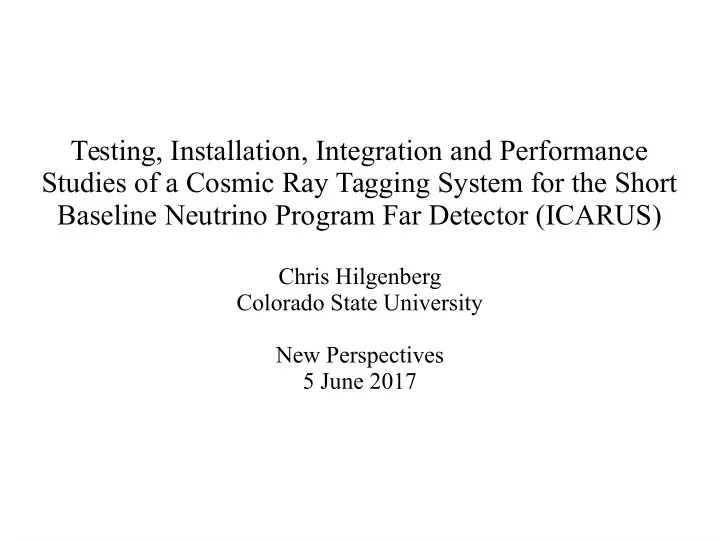

Testing, Installation, Integration and Performance Studies of a Cosmic Ray Tagging System for the Short Baseline Neutrino Program Far Detector (ICARUS) Chris Hilgenberg Colorado State University New Perspectives 5 June 2017
Outline 1) ICARUS past and present 2) Operating a LAr TPC on the Surface 3) Cosmogenic background mitigation 4) Cosmic ray tagger (CRT) conceptual design 5) Initial R&D at CSU 6) Top, side, and bottom CRT subsystems 7) Current Status 5 June 2017 Hilgenberg 2
ICARUS Past and Present ● Largest LAr TPC w/760(476 active) tons LAr ● Two 300-ton capacity cryostats w/TPC (T300s), 4 drift volumes ● Operated at LNGS for ~3 yr (below 3400 mwe) ● Made measurements on CNGS ν's and CRs ● WA104 at CERN – refurbished both modules Drift distance 1.5 m T300 Drift time 1 ms 5 June 2017 Hilgenberg 3
Operating a LAr TPC on the Surface *Image provided by Anne Schukraft ● TPC positioned 9.7 m below surface w/3-m concrete overburden ● MC predicts ~12 kHz μ's passing through LAr ● ~6 μ's will pass through LAr in 1 drift time per module ● μ's passing through or near LAr can produce γ's which mimic ν e CCQE topology *See http://nufact09.iit.edu/wg2/wg2_antonello-microbooneargoneut.pdf 5 June 2017 Hilgenberg 4
Cosmogenic Background Mitigation *See https://indico.in2p3.fr/event/11794/session/3/contribution/44/material/slides/0.pdf ● Several methods to remove background w/TPC – dE/dx in initial part of shower – Distance of vertex candidate from μ track – Exploit beam spill structure ● Using tracker external to TPC volume to tag μ's – clean means of background rejection – tool for real time monitoring (e.g. LAr purity) *See SBN proposal 5 June 2017 Hilgenberg 5
Cosmic Ray Tagger Conceptual Design ● Fully encase cryostat w/plastic scintillator (~800 m 2 ) ● Guide light to SiPMs w/WLS fiber ● Use dual-layer coincidence to suppress radiogenic background ● Arrange scintillator strips in X-Y configuration ● Require >95% tagging efficiency 5 June 2017 Hilgenberg 6
Initial R&D at CSU ● Extruded polystyrene-based scintillator from FNAL Extrusion Facility ● 5-cm strips used to build wider sections ● Used U-Bern front-end electronics for all measurements ● Tested several models of Hamamatsu and SensL SiPMs ● Many prototypes designed, built, and tested ● Measured effect of fiber diameter, attenuation length, fiber mirroring, optical coupling, fiber position, ganging... ● Final design achieved ~97% tagging efficiency at worst point Vertical μ's 5 June 2017 Hilgenberg 7
CRT Subsystems ● Collaborative effort between Europe and US – CERN & Bologna will design and construct new modules similar to SBND design – Re-use of MINOS FD scintillator modules with a new SiPM based readout by FNAL and CSU – Re-use of Double Chooz veto modules by FNAL in collaboration with UChicago and VT ● Extra complications for DAQ, simulation and analysis ● Cost saving solution for ICARUS’ large surface area *Photo credit: Justin Tilman 5 June 2017 Hilgenberg 8
Sides: MINOS Modules ● 1cm x 80 cm x 8m ● Fibers read out at both ends ● Front-end electronics originally designed for underground CR rates (~1 Hz) ● Aging scintillator light yield loss ~2% / year See Nuclear Instruments and Methods in Physics Research A 596 (2008) 190-228 5 June 2017 Hilgenberg 9
Sides: Readout Development ● Desirable to use same front-end electronics as top CRT system ● SiPMs offer >3x PDE w.r.t. PMTs ● Direct readout avoids interface losses ● Fiber spacing is not ideal for existing SiPM geometries ● Close-packed 1-mm 2 active area SiPMs allow single fiber readout but w/light loss (fiber diameter 1.1 mm) ● Other configurations being considered *Design and fabrication performed at CSU 5 June 2017 Hilgenberg 10
Sides: Testing at Wideband 168 modules Vertical μ's Hod. Preliminary result: yield 1-2 PE higher than MINOS result 5 June 2017 Hilgenberg 11
Bottom: Double Chooz Modules ● 2cm x 1.7 m x 4m ● Single strips read out by multi-anode PMT ● Scintillator modules designed and constructed by University of Chicago ● In collaboration with Virginia Tech ● All readout electronics custom design by NEVIS/Columbia 5 June 2017 Hilgenberg 12
Bottom: Installation *Photo credit: Simone Marcocci ● 4 spare modules from Uchicago - Much help from V. Pandey (VT) - tested for light leaks - source tested for broken fibers ● Installation went smoothly ahead of schedule on 8 May 5 June 2017 Hilgenberg 13
Current Status ● The two ICARUS T300s will be shipped from CERN in mid- June ● A summer intern team will be assisting us in testing and characterizing all 168 MINOS modules by the end of summer ● The last 10 Double Chooz modules will be tested and installed mid-June ● The mechanical support for the top and sides will be finalized this summer ● The sides readout design will be finalized by this fall 5 June 2017 Hilgenberg 14
Credits ● CSU group ● FNAL group – Robert J. Wilson, advisor Anne Schukraft, assoc. scientist – – Tyler Boone, grad student Simone Marcocci, post doc – – David Warner, sr. engineer Justin Tilman, designer – – Jay Jablonski, sr. technician John Bell, mech. engineer – – Bob Adame, machinist ● Virginia Tech group – Blake Troksa, undergrad electrical engineer Camillo Mariani, assoc. professor – ● CERN group Vishvas Pandey, post doc – – Paola Sala, assoc. scientist University of Chicago ● – Umut Kose, assoc. scientist Ed Blucher – 5 June 2017 Hilgenberg 15
Recommend
More recommend